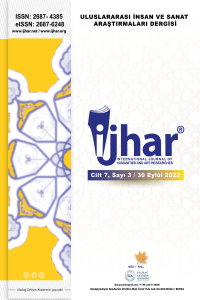Abstract
It is seen that the cultural elements of deep-rooted nations from the past to the present are used extensively in the field of art, as in many other fields. In this context, it would not be wrong to say that the pigeon figure is among the cultural elements in question. For this reason, it is thought that it is very important to investigate how and in what meaning the pigeon figure is used in contemporary Turkish painting, and to determine the examples of the reflections of the relevant figure in painting and to collect the evaluations of the principles of use under one title.
In Turkish painting, the pigeon figure can be seen in a few works of master painters such as Osman Hamdi Bey and Hoca Ali Rıza. However, the artists in question did not use the relevant figure as a dominant element in their works. In addition, contemporary Turkish art has been greatly affected by the political, economic and cultural changes after 1950, enabling artists to produce more individual works in terms of form, subject and meaning. In this context, the research is based on the artists who produced works in the contemporary Turkish painting art between 1950-2020; It is limited to the examples of works with pigeon theme by Ferruh Başağa, Kadir Şişginoğlu and Orhan Peker. The stable attitudes of the artists selected for study within the scope of the research topic were the reference in their preference. Qualitative research methods and techniques were used in the study, which was based on the general scanning model. In order to obtain qualitative data, "document review and interview" method was used in the research process.
References
- Alaybeyi, Emine (2018). Çağdaş Türk Resim Sanatında Milli Değerler Bağlamında Figüratif Betimlemeler. Resim Anabilim Dalı Yüksek Lisans Tezi, Mardin Artuklu Üniversitesi, Sosyal Bilimler Enstitüsü, Mardin.
- Bulut, Arzu (2009). Çağdaş Türk Resim Sanatı’nda Onlar Grubu. Resim Anasanat Dalı Yüksek Lisans Tezi, Atatürk Üniversitesi, Sosyal Bilimler Enstitüsü, Erzurum.
- Dalkıran, Ahmet (2010). Çağdaş Türk Resminde Şamanist Etkiler. Güzel Sanatlar Anabilim Dalı Doktora Tezi, Selçuk Üniversitesi, Sosyal Bilimler Enstitüsü, Konya.
- Edeer, Şemsettin (2015). Orhan Peker’in Resimlerinde Lekeci Anlatım. Sanat ve Tasarım Dergisi, Sayı/1, 61-74.
- Erman, Deniz Onur (2009). Seramik Sanatında Kuş Figürü Üzerine Kişisel Uygulamalar. Seramik Anasanat Dalı Sanatta Yeterlik Tezi, Hacettepe Üniversitesi, Sosyal Bilimler Enstitüsü, Ankara.
- Eskigün, Kübra (2006). Klasik Türk Şiirinde Efsanevi Kuşlar. Türk Dili ve Edebiyatı Anabilim Dalı Yüksek Lisans Tezi, Kahramanmaraş Sütçü İmam Üniversitesi Sosyal Bilimler Enstitüsü, Kahramanmaraş.
- Gezen, M. Cihan (2016). Cumhuriyetten Günümüze Türk Resminde Eşzamanlı Devinim. Resim Anasanat Dalı Yüksek Lisans Tezi, Selçuk Üniversitesi, Sosyal Bilimler Enstitüsü, Konya.
- Giray, Kıymet (2003) Ferruh Başağa. İstanbul: Türkiye İş Bankası Yayınları.
- Göğebakan, Yüksel (2010). Kültürel Mirasın Türk Resim Sanatına Yansıması. Mimar Sinan Güzel Sanatlar Üniversitesi Sosyal Bilimler Enstitüsü Dergisi, Sayı/1, 88-100.
- Gürel, Haşim Nur (2000). Ferruh Başağa Soyutun Duayeni- Ferruh Başağa Kataloğu. İstanbul: Yapı Kredi Yayınları.
- Halıcı, Esra (2017). Orhan Peker ve Türk Resim Sanatındaki Yeri. Atatürk Üniversitesi Güzel Sanatlar Enstitüsü Dergisi, Sayı/38, 51-68.
- İpşiroğlu, Nazan (2000). Kurgu ve Sezgi Ferruh Başağa’nın Resimlerindeki Müziksellik- Ferruh Başağa Kataloğu. İstanbul: Yapı Kredi Yayınları.
- Kayapınar, Umut (2016). Türk Resminde Soyut Yaklaşımlar. Akdeniz Sanat Dergisi, Sayı/18, Cilt/9, 50-73.
- Küçükerman, Önder, Berk, İ. (1994). Ressam Orhan Peker. Milli Reasürans Sanat Galerisi, İstanbul.
- Levy, Leopold (2000). Resim Sergisi- Ferruh Başağa Kataloğu. İstanbul: Yapı Kredi Yayınları.
- Musal Çakmaklısoy, Harika (2017). Çağdaş Türk Resim Sanatında Kuş İmgesinin Hareket Bağlamında İncelenmesi. İdil Dergisi, S/38, 2751-2771.
- Rona, Zeynep (2008). Orhan Peker- Modern ve Ötesi:1950-2000. İstanbul: İstanbul Bilgi Üniversitesi Yayınları.
- Sökmen, Sultan, Balkanal, Zeynep (2021). Anadolu Sanatında Şahmeran Figürlü Örnekler. Uluslararası Hakemli İnsan ve Sanat Araştırmaları Dergisi. S/6, 417-447.
- Tanpınar, Ahmet Hamdi (2000). Resim Sergisi- Ferruh Başağa Kataloğu. İstanbul: Yapı Kredi Yayınları.
- Giray, Kıymet (2015). http://www.antikalar.com/v2/konuk/konuk1109.asp. , E. T. 12.04.2020.
- Şişginoğlu, Kadir (2017). http://kadirsisginoglu.blogspot.com/2017/, E. T. 12.04.2020.
- Şişginoğlu, Kadir. Akademisyen ve Ressam. Yaş:59, Online Sözlü Görüşme, 20 Mart 2020, Trabzon.
Abstract
Geçmişten günümüze köklü milletlerin sahip oldukları kültür unsurlarının, diğer birçok alanda olduğu gibi sanat alanında da yoğun şekilde kullanıldığı görülmektedir. Bu bağlamda, söz konusu kültür unsurları içerisinde güvercin figürünün olduğunu da söylemek yanlış olmayacaktır. Bu nedenle güvercin figürünün çağdaş Türk resim sanatında ne şekilde ve ne anlamlarda kullanıldığının araştırılması ve ilgili figürün resim sanatındaki yansımalarına ait örneklerinin tespit edilerek kullanım esaslarına ait değerlendirmelerin bir başlık altında toplanmasının oldukça önem arz ettiği düşünülmüştür.
Türk resminde Osman Hamdi Bey ve Hoca Ali Rıza gibi usta ressamların birkaç eserinde güvercin figürü görülmektedir. Ancak söz konusu sanatçılar ilgili figürü eserlerinde başat unsur olarak kullanmamışlardır. Ayrıca çağdaş Türk sanatı 1950 sonrası siyasi, ekonomik ve kültürel değişimlerden çokça etkilenmiş, sanatçıların biçim, konu ve anlam açısından daha bireysel eserler üretmesini sağlamıştır. Bu kapsamda araştırma, 1950-2020 yılları arasında çağdaş Türk resim sanatı içerisinde eser üreten sanatçılardan; Ferruh Başağa, Kadir Şişginoğlu ve Orhan Peker’e ait güvercin teması görülen eser örnekleri ile sınırlıdır. İncelenmek üzere seçilen sanatçıların araştırma konusu kapsamındaki istikrarlı tutumları tercih edilmelerinde referans olmuştur. Genel tarama modelinin esas alındığı araştırmada, nitel araştırma yöntem ve teknikleri kullanılmıştır. Nitel verileri elde edebilmek için araştırma sürecinde “doküman incelemesi ve görüşme” yöntemi kullanılmıştır.
References
- Alaybeyi, Emine (2018). Çağdaş Türk Resim Sanatında Milli Değerler Bağlamında Figüratif Betimlemeler. Resim Anabilim Dalı Yüksek Lisans Tezi, Mardin Artuklu Üniversitesi, Sosyal Bilimler Enstitüsü, Mardin.
- Bulut, Arzu (2009). Çağdaş Türk Resim Sanatı’nda Onlar Grubu. Resim Anasanat Dalı Yüksek Lisans Tezi, Atatürk Üniversitesi, Sosyal Bilimler Enstitüsü, Erzurum.
- Dalkıran, Ahmet (2010). Çağdaş Türk Resminde Şamanist Etkiler. Güzel Sanatlar Anabilim Dalı Doktora Tezi, Selçuk Üniversitesi, Sosyal Bilimler Enstitüsü, Konya.
- Edeer, Şemsettin (2015). Orhan Peker’in Resimlerinde Lekeci Anlatım. Sanat ve Tasarım Dergisi, Sayı/1, 61-74.
- Erman, Deniz Onur (2009). Seramik Sanatında Kuş Figürü Üzerine Kişisel Uygulamalar. Seramik Anasanat Dalı Sanatta Yeterlik Tezi, Hacettepe Üniversitesi, Sosyal Bilimler Enstitüsü, Ankara.
- Eskigün, Kübra (2006). Klasik Türk Şiirinde Efsanevi Kuşlar. Türk Dili ve Edebiyatı Anabilim Dalı Yüksek Lisans Tezi, Kahramanmaraş Sütçü İmam Üniversitesi Sosyal Bilimler Enstitüsü, Kahramanmaraş.
- Gezen, M. Cihan (2016). Cumhuriyetten Günümüze Türk Resminde Eşzamanlı Devinim. Resim Anasanat Dalı Yüksek Lisans Tezi, Selçuk Üniversitesi, Sosyal Bilimler Enstitüsü, Konya.
- Giray, Kıymet (2003) Ferruh Başağa. İstanbul: Türkiye İş Bankası Yayınları.
- Göğebakan, Yüksel (2010). Kültürel Mirasın Türk Resim Sanatına Yansıması. Mimar Sinan Güzel Sanatlar Üniversitesi Sosyal Bilimler Enstitüsü Dergisi, Sayı/1, 88-100.
- Gürel, Haşim Nur (2000). Ferruh Başağa Soyutun Duayeni- Ferruh Başağa Kataloğu. İstanbul: Yapı Kredi Yayınları.
- Halıcı, Esra (2017). Orhan Peker ve Türk Resim Sanatındaki Yeri. Atatürk Üniversitesi Güzel Sanatlar Enstitüsü Dergisi, Sayı/38, 51-68.
- İpşiroğlu, Nazan (2000). Kurgu ve Sezgi Ferruh Başağa’nın Resimlerindeki Müziksellik- Ferruh Başağa Kataloğu. İstanbul: Yapı Kredi Yayınları.
- Kayapınar, Umut (2016). Türk Resminde Soyut Yaklaşımlar. Akdeniz Sanat Dergisi, Sayı/18, Cilt/9, 50-73.
- Küçükerman, Önder, Berk, İ. (1994). Ressam Orhan Peker. Milli Reasürans Sanat Galerisi, İstanbul.
- Levy, Leopold (2000). Resim Sergisi- Ferruh Başağa Kataloğu. İstanbul: Yapı Kredi Yayınları.
- Musal Çakmaklısoy, Harika (2017). Çağdaş Türk Resim Sanatında Kuş İmgesinin Hareket Bağlamında İncelenmesi. İdil Dergisi, S/38, 2751-2771.
- Rona, Zeynep (2008). Orhan Peker- Modern ve Ötesi:1950-2000. İstanbul: İstanbul Bilgi Üniversitesi Yayınları.
- Sökmen, Sultan, Balkanal, Zeynep (2021). Anadolu Sanatında Şahmeran Figürlü Örnekler. Uluslararası Hakemli İnsan ve Sanat Araştırmaları Dergisi. S/6, 417-447.
- Tanpınar, Ahmet Hamdi (2000). Resim Sergisi- Ferruh Başağa Kataloğu. İstanbul: Yapı Kredi Yayınları.
- Giray, Kıymet (2015). http://www.antikalar.com/v2/konuk/konuk1109.asp. , E. T. 12.04.2020.
- Şişginoğlu, Kadir (2017). http://kadirsisginoglu.blogspot.com/2017/, E. T. 12.04.2020.
- Şişginoğlu, Kadir. Akademisyen ve Ressam. Yaş:59, Online Sözlü Görüşme, 20 Mart 2020, Trabzon.
Details
| Primary Language | Turkish |
|---|---|
| Journal Section | Research Articles |
| Authors | |
| Publication Date | September 30, 2022 |
| Submission Date | December 8, 2021 |
| Acceptance Date | September 7, 2022 |
| Published in Issue | Year 2022 Volume: 7 Issue: 3 |




International Journal of Human and Art Studies İJHAR; Licensed under the Creative Commons Attribution 4.0 International License.
International Journal of Human and Art Studies IJHAR has been registered with the decision of the Turkish Patent and Trademark Office, numbered 71248886-2020/24446 / E.2020-OE-458377.

